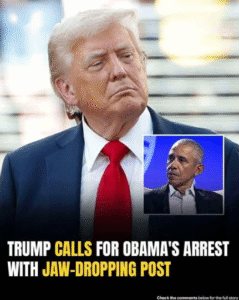Former President Donald Trump is facing intense backlash after posting a fake AI-generated video depicting former President Barack Obama being arrested. The controversial clip, which quickly went viral across social media platforms, was widely condemned as misleading, inflammatory, and dangerous. Critics from both political parties, fact-checkers, and digital ethics experts have called out the video for spreading false information and stoking division.
The AI-generated footage, crafted with highly realistic visual and audio elements, appeared to show Obama being handcuffed and escorted by law enforcement officers. The video was accompanied by cryptic captions suggesting accountability and justice, though it made no direct claim about the video’s authenticity. However, to many viewers, it looked real enough to cause confusion and outrage.
Digital experts quickly confirmed that the video was an artificial creation, likely produced using deepfake technology. Deepfakes use AI to manipulate or fabricate video content, often blending real voices and likenesses to create extremely realistic but entirely fictional scenarios. Within hours, fact-checking organizations labeled the clip as fake and flagged it across social media platforms.
Despite the widespread recognition that the video was manufactured, the damage had already been done. Millions of users had already seen, shared, and commented on the footage before it was removed or labeled by content moderators. The post sparked outrage, with many accusing Trump of knowingly sharing false content to inflame his base and distract from ongoing legal or political challenges.
Obama’s representatives declined to comment publicly at first, but a source close to the former president called the video “a pathetic and dangerous escalation in the use of disinformation.” Prominent Democrats, civil rights leaders, and media watchdog groups demanded accountability and stronger guardrails to prevent the spread of harmful AI-generated media.
Republicans were divided in their responses. Some staunch Trump allies dismissed the outrage as overblown, calling it satire or protected speech. Others, however, voiced concern about the increasing use of AI to manipulate public perception. A few GOP lawmakers joined bipartisan calls for regulations to address the growing threat of deepfake technology being weaponized in politics.
Legal experts noted that while the video may not technically violate current laws, it raises serious questions about the boundaries of free speech, digital manipulation, and electoral integrity. The timing of the video—coming amid heightened political tensions and ongoing campaign activity—added to concerns about the erosion of truth in the public sphere.
Social media companies scrambled to respond. Some platforms removed the video entirely, while others added disclaimers clarifying that it was not real. Critics argued these measures came too late and demanded stronger policies and faster enforcement. Civil society groups warned that as AI tools become more accessible, the risk of similar incidents will only increase—particularly during election cycles.
The incident has renewed calls for federal legislation to regulate deepfakes and AI-generated disinformation. Several senators, including members of both parties, announced plans to reintroduce bills targeting deceptive AI media, citing the Trump video as a clear example of the technology’s potential to cause harm.
Trump himself has not issued a formal apology or clarification. In follow-up posts, he doubled down, claiming the media was overreacting and that the video was intended as “a commentary on double standards.” He accused critics of hypocrisy and claimed he was being targeted for exercising free speech. His comments only deepened the controversy and drew further condemnation.
Media analysts say the episode illustrates a troubling new frontier in political propaganda—where truth can be manufactured and manipulated in seconds, and public trust becomes harder than ever to preserve. The incident also reveals how easily AI tools can be used to generate false but persuasive content that spreads faster than corrections or fact-checks can catch up.
In conclusion, Trump’s decision to post a fake AI video of Obama’s arrest has ignited a firestorm of criticism and sparked urgent debate about digital ethics, free speech, and the future of political communication. As deepfake technology continues to evolve, experts warn that without swift action, the line between fact and fiction will blur even further—threatening democracy, public discourse, and truth itself.


